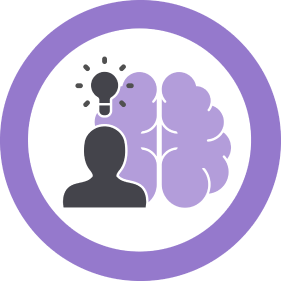Professional Learning
Intent:
To ensure fidelity of UDL implementation, professional learning aligns with school-wide and practitioner UDL goals that are developed in response to ongoing school-wide and classroom data. Professional learning goals should directly address identified learning gaps.
Indicators:
Professional learning is goal-driven and is:
-
designed by or facilitated by professionals knowledgeable about UDL;
-
based on school-wide, data-driven UDL implementation goals;
-
used to address professional goals to improve UDL practices; and
-
dynamic and improved in response to evolving UDL implementation and student outcome data.
Intent:
To ensure continuous improvement in professional learning practices, the UDL leadership team designs professional learning opportunities to meet the needs of school-wide and individual staff goals by providing flexible pathways to support variability in the staff.
Indicators:
Professional learning is designed to:
-
meet the needs of school-wide and individual staff professional learning goals;
-
reduce barriers to learning in anticipation of staff variability;
-
provide flexible pathways, including options and choices, toward meeting professional learning goals.
Resources:
Intent:
Professional learning experiences are designed to help educators become expert learners themselves--that is, purposeful, motivated, resourceful, knowledgeable, strategic, and goal-directed.
Indicators:
Professional learning:
-
is designed to cultivate the qualities of expert learning;
-
includes strategies and practices educators can use to support/develop expert learners in the classroom; and
-
includes strategies and practices that promote expert educators
Intent:
Professional learning is designed to ensure that educators are provided with the best opportunities to successfully transfer new skills into practices that meet the needs of all learners. Professional learning models are supported, collaborative, and based on authentic problems of practice. They engage educators and help make explicit the connection between professional learning and its application to daily practice.
Indicators:
Professional learning is job-embedded and uses:
-
a systematic model for job-embedded continuous improvement. This may include, but is not limited to, various instructional coaching models, peer-mentoring, instructional rounds, instructional cycles, lesson study, and professional learning communities.
-
personnel who have the requisite UDL knowledge and skills;
-
data to inform continuous support plans; and
-
authentic problems of practice.
Resources:
UDL Learning Walks (Montgomery County Public Schools)
Borko, H. (2004). Professional development and teacher learning: mapping the terrain. Educational Researcher, 33, 8, 3–15.
https://doi.org/10.3102/0013189X033008003
Courey, S. J., Tappe, P., Siker, J., & LePage, P. (2012). Improved lesson planning with Universal Design for Learning (UDL). Teacher Education and Special Education, 36, 7–27. https://doi.org/10.1177/0888406412446178
Craig, S. L. (2020). Effects of coaching on universal design for learning implementation (Order No. 28024556). Available from ProQuest Dissertations & Theses Global. (2445998955).
https://go.openathens.net/redirector/bc.edu?url=https://www.proquest.com/dissertations-theses/effects-coaching-on-universal-design-learning/docview/2445998955/se-2?accountid=9673
Craig, S. L., Smith, S. J., & Frey, B. B. (2019). Professional development with universal design for learning: supporting teachers as learners to increase the implementation of UDL. Professional Development in Education, 1-16.
https://doi.org/10.1080/19415257.2019.1685563
Cwikla, J. (2003). The Importance of Setting Learning Goals to Investigate the Effectiveness of Teacher Professional Development. Educational Research Quarterly, 27(2), 43-59.
https://go.openathens.net/redirector/bc.edu?url=https://www.proquest.com/scholarly-journals/importance-setting-learning-goals-investigate/docview/216183954/se-2?accountid=9673
Day, C., & Gu, Q. (2007). Variations in the conditions for teachers’ professional learning and development: sustaining commitment and effectiveness over a career. Oxford Review of Education, 33(4), 423–443. doi:10.1080/03054980701450746
Desimone, L. M. (2009). Improving impact studies of teachers’ professional development: Toward better conceptualizations and measures. Educational Researcher, 38(3), 181–199. doi:10.3102/0013189x08331140
Garet, M. S., Porter, A. C., Desimone, L., Birman, B. F., & Yoon, K. S. (2001). What makes professional development effective? Results from a national sample of teachers. American Educational Research Journal, 38(4), 915–945. doi:10.3102/00028312038004915
Gravani, M. (2007). Unveiling professional learning: Shifting from the delivery of courses to an understanding of the processes. Teaching and Teacher Education, 23, 688-704.
Hullinger, A. and DiGirolamo, J. (2020) A professional development study: The lifelong journey of coaches, International Coaching Psychology Review, 13(1), pp.7-18.
Jasso, L. K. (2018). Teacher Perceptions of Effective Instructional Coaching in Professional Development Support (Order No. 10976245). [Doctoral dissertation, Concordia University Irvine] ProQuest Dissertations & Theses Global.
https://eric.ed.gov/?id=ED592134
King, M. B., & Newmann, F. M. (2000). Will teacher learning advance school goals? Phi Delta Kappan, 81(8), 576-580.
https://go.openathens.net/redirector/bc.edu?url=https://www.proquest.com/scholarly-journals/will-teacher-learning-advance-school-goals/docview/218472777/se-2?accountid=9673
Knight, J., & Cornett, J. (2009). Studying the Impact of Instructional Coaching. American Educational Research Association. , San Diego, California.
https://drive.google.com/file/d/16ml1kbkEICdVLYZUd4c_Vxy5AvVWlE47/view
Parsons, S. A., Vaughn, M., Scales, R. Q., Gallagher, M. A., Parsons, A. W., Davis, S. G., … Allen, M. (2017). Teachers’ instructional adaptations: A research synthesis. Review of Educational Research, 88, 205–242. doi:10.3102/0034654317743198
Scott, L., Temple, P., & Marshall, D. (2015). UDL in online college coursework: Insights of infusion and educator preparedness. Online Learning, 19, 99-119.
https://doi.org/10.24059/olj.v19i5.623
Spooner, F., Baker, J. N., Harris, A. A., Ahlgrim-Delzell, L., & Browder, D. M. (2007). Effects of training in Universal Design for Learning on lesson plan development. Remedial and Special Education, 28 108–116.
https://doi.org/10.1177/07419325070280020101
Webster-Wright, A. (2009). Reframing Professional Development Through Understanding Authentic Professional Learning. Review of Educational Research, 79(2), 702–739.
https://doi.org/10.3102/0034654308330970
Yoon, K. S., Duncan, T., Lee, S. W.-Y., Scarloss, B., & Shapley, K. (2007). Reviewing the evidence on how teacher professional development affects student achievement. In IES Regional Educational Laboratory Program. U.S. Department of Education, Institute of Education Sciences, National Center for Education Evaluation and Regional Assistance, Regional Education.
https://drive.google.com/file/d/1S-lxuhjA1RCEDehLY52CEVTTqVxJwO1v/view
Zhang, L., Carter, R. A., Zhang, J., Hunt, T. L., Emerling, C. R., Yang, S., & Xu, F. (2021). Teacher perceptions of effective professional development: insights for design. Professional Development in Education, 1–14.
https://doi.org/10.1080/19415257.2021.1879236
Attribution-NonCommercial-NoDerivs
CC BY-NC-ND
This license allows reusers to copy and distribute the material in any medium or format in unadapted form for non-commercial purposes only and only so long as attribution is given to the creator.

